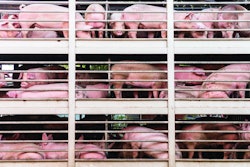
Animal feed can carry viruses, so prevention and biosecurity are key to keep African swine fever out of places where it has not been detected.
The battle against the African swine fever (ASF) virus continues since its last encounter in Georgia during 2018. It remained a local problem, destroying pig production in countries around Russia, where it quickly spread, until it jumped into East Asia and finally Western Europe. There is no successful cure or vaccine for this viral disease, and a nutritionist, like me, has very little to say about it. But, this is changing fast as we will discuss here.
Just last July, I was invited by Dr. Eckel Animal Nutrition, a German company, to give a presentation about the relationship between pig feed and ASF. As it happened, days prior to the long-before scheduled event, ASF was detected for the first time at the critical border between Germany and The Netherlands, which is right in the heart of the pig production areas for both countries. Previously, the virus had been detected in Belgium, but it was rather restrained in the border of Germany and Poland. Hitting the western border was a rude awakening, as no prior incidence with wild boar infections had been recorded there – as is usually the rule for most cases.
During this unfortunate time, I had to answer two simple questions regarding feed and ASF: Can feed be a vector for the ASF virus and, if yes, can we do something about it? The answer is, yes, animal feeds can carry viruses, and this is not news.
Experiences from PED virus in the US
During the unprecedented outbreak of PED virus disease affecting newborn pigs in the U.S. and Canada, there has been ample discussion about the role of feed in spreading the disease. A single feed plant in Canada was associated (right or wrong) with spreading the disease in scores of farms. Certain raw materials of animal origin were blamed (right or wrong) for carrying and spreading the disease, and indeed such raw materials are still struggling to make a complete recovery. And, finally, the virus was detected in certain imported premixes. All in all, without blaming anyone, it was clear to everyone that animal feed and feed ingredients were able to retain and transmit the PED virus, although it was near impossible to have certain proof that such transmission was enough to actually cause the disease. Viral diseases require a certain load and exposure time – as we all have learned by our own COVID-related problems.
Work on ASF at Kansas State University
The ASF virus has not entered the Americas, and to my information, authorities are doing their best to prevent this, although many believe it is an issue of when and not if. Nevertheless, the U.S. is preparing for the inevitable by doing some strong research on the relationship between feed and ASF, in addition to developing a vaccine. Kansas State University, where I did my M.Sc. studies, was first to demonstrate that animal feed and feed ingredients can harbor the virus. In fact, several ingredients and complete pig feed was shown to retain the virus after a trans-Atlantic simulated trip. This was the work of Dr. Megan Niederwerder and her co-workers at the College of Veterinary Medicine.
It was demonstrated that not only the virus survived the harsh conditions of the trip, but it was also strong enough to infect pigs – although they would have to eat large quantities of the contaminated feed or smaller ones but more often. As it happens, this is exactly the case in most pig production facilities as young pigs eat ad libitum all day long, whereas breeding pigs consume large meals two to three times per day. So, it is possible to infect pigs through such imported feed, but the likelihood depends – as always – on the degree of exposure.
 Breeding pigs may be infected by heavily contaminated dry feed as they eat large meals. (ChiccoDodiFC | BigStock.com)
Breeding pigs may be infected by heavily contaminated dry feed as they eat large meals. (ChiccoDodiFC | BigStock.com)The situation so far
So, to answer again the question whether pig feed can contribute to the ASF problem, we can say with confidence the following:
- Yes, animal feed and ingredients can be a potent vector for ASF virus.
- However, the virus concentration needs to be high and the exposure continuous.
- Growing pigs may be infected by heavily contaminated dry feed as they eat several meals a day.
- Breeding pigs may be infected by heavily contaminated dry feed as they eat large meals.
- Contamination through liquids (liquid feed or supplements in the water) requires lower viral concentration/exposure to be infectious compared with consumption of dry feed.
- Feed mills can be a major source of viral contamination as the virus spreads there widely once it enters the facilities and this requires extra biosecurity measures.
- Buying several feed ingredients of unknown origin from many suppliers poses a greater risk than buying locally or from sources known to be from non-infected areas.
- Animal products are likely to be riskier unless properly treated, but this requires further qualification as all assumptions are based on our PED viral outbreak.
Prevention is the key
Once a farm is infected with ASF virus, all pigs are euthanized. There is no alternative at the moment. So, preventing the virus from entering the farm is the only way to avoid complete loss. Even culling entire healthy pig populations in a radius of several kilometers around an infected farm in Europe and Asia has proven rather ineffective. Nutrition can play a role in prevention, as we will discuss later, but the majority of the work falls on the shoulders of veterinarians, who must ensure ASF-free status for as long as possible.

















